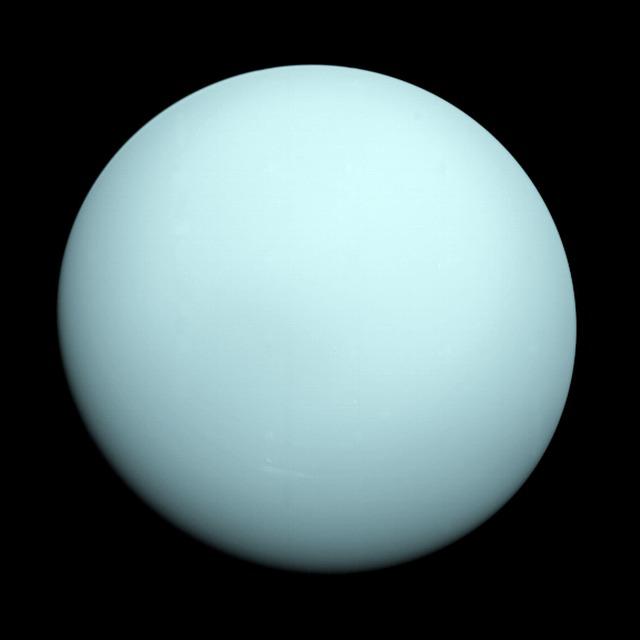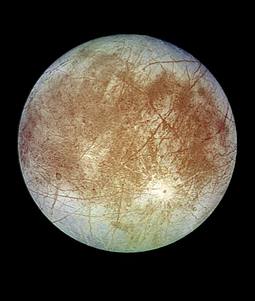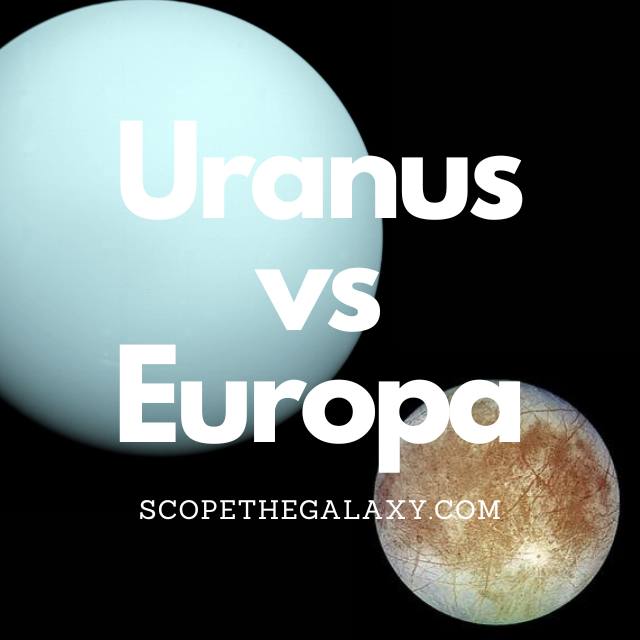*This post may contain affiliate links. This means we may make a commission if you purchase an item using one of our links*
The main differences between Uranus and Europa is that Uranus is an ice giant, has 27 moons orbiting it and has the most extreme axial tilt at 98 degrees whereas Europa is the smallest of Jupiter’s Galilean moons, is a terrestrial based entity with water ice present on its surface, has no other moons orbiting it and has a very straight axial tilt of 0.1 degrees.
There are numerous other differences between the two so continue reading for a more thorough breakdown of each celestial body below.
What Is The Planet Uranus?
Table of Contents

Uranus is the 7th farthest planet from the Sun and the 3rd largest planet in our solar system, coming in at a diameter of 50,724 km. This means that roughly 63 Earth’s could fit inside this ice giant.
In regards to why this cyan blue planet is referred to as an ice giant, it’s down to it’s composition. Uranus is made mostly of methane, ammonia and water with its atmosphere mostly consisting of hydrogen and helium, much like the Sun, and the other giant planets in our solar system.
Due to its distance from the Sun, it takes Uranus 84 years to complete one orbit our central star, whereas it’s axial rotation is much faster than even our Earth at 17 hours per rotation.
As a result of its distance from the Sun, ice based composition and faster rotation levels, Uranus is far from an ideal place to live in let alone have the potential to support life.
Its base temperature is generally a chilling -190 to -200 degrees Celsius and its rocky core, although hot, is still on the cooler side for a large planet sitting around the 5,000 degrees Celsius range.
The planet’s winds are also very fast often hitting 900 km/h, which is roughly twice that of Earth’s most powerful turbulent wind speeds.
In regards to the moons surrounding this cyan planet, we’ve discovered 27 small ones orbiting it. Furthermore, it has 13 rings surrounding it which also means Uranus has the most abundant collection of rings surrounding in our solar system, which is even more than Saturn.
One of the Uranus’ most unique features would include the manner in which it rotates around its axis. As opposed to the slightly angled rotation that the likes of Earth, Saturn and most other planets display, Uranus’ axis is positioned at a 98 degree angle.
What this means is this ice giant completes an axial rotation on its side as opposed to the relatively up straight positioning of most of the other planets in our solar system.
What Is The Moon And Europa?

Europa is the smallest of the Galilean moons, first discovered on 8th January 1610. The surface of this icy world is frozen, but scientists believe a watery ocean could lie beneath the surface. And in 2012, researchers found a possible water plume in the Southern polar region of Europa.
This research is yet to be confirmed; still, it gives us reasonable grounds to hypothesize that water could exist on this icy moon.
Estimates place Europa at around 4.5 billion years old (the same age as its planet, Jupiter), and its average distance from the Sun is approximately 780 million km.
It has a diameter of 3,121.6km, which makes it larger than Pluto but smaller than the Earth’s moon, and the maximum temperature is a chilly -160 degrees Celsius. In regards to mass, it measures in around 4.8 × 10^22 kg.
Europa takes three-and-a-half days to orbit its planet at an average distance of 670,900km, and it is tidally locked, meaning the same side of the moon always faces Jupiter.
Among the fascinating features of this ice moon is its incredibly reflective nature. The icy crust of this body provides a light reflectivity of 0.64 – the highest of any moon in the solar system.
Data from the Galileo spacecraft suggests that Europa is composed of an iron core, rocky mantle, and silicate rock (a similar composition to Earth).
The moon’s surface is covered in cracks, which many theorize could result from tidal currents beneath the surface. It is this potential of water – and of life – that keeps astronomers so interested in this moon.
Europa might be small, but astronomers estimate it holds two to three times more water than the Earth. In addition, this moon possesses the essential elements for life, such as carbon, oxygen, hydrogen, and nitrogen.
There may be no solar energy on this moon, but hydrothermal vents could provide energy, and tidal heating from Jupiter could provide a heat source and keep the moon stable enough for life to form. In addition, the liquid ocean is well protected from radiation from thick, icy surfaces.
Similarities Between Uranus And Europa
Uranus and Europa don’t have too many similarities but some elements are still shared, which in this case includes the below:
- Both are a spherical shape.
- Both have a hotter core.
- Both also orbit another entity.
- Neither have tectonic plates.
- Both are part of the same solar system.
Differences Between Uranus And Europa
In regards to the differences between the two, they include the following:
- Uranus is the bigger of the two with a diameter of 50,724km compared to Europa’s that is 3121.6km.
- Uranus has 27 moons whilst Europa has 0.
- Europa orbits the Sun in 12 years whilst Uranus orbits the Sun in 84 years.
- Europa is tidally locked to Jupiter whilst Uranus is not tidally locked to anything.
- Uranus completes a day in 17 hours whilst Europa completes a day in 3.5 days.
- Uranus has the most extreme axial tilt in our solar system where it is 98 degrees compared to Europa’s that is 0.1 degrees.
- Europa has 0 rings around it whilst Uranus has 13.
- Europa is a terrestrial based natural satellite with ice water on its surface whilst Uranus is a gas based ice giant with icy materials composed of water, methane, and ammonia above its small rocky core.
- Uranus’ density is 1.27 g/cm³ whilst Europa’s density is 3.01 g/cm³.
- Europa has no magnetosphere whilst Uranus does have a magnetosphere.
- Uranus’ mass is 8.681 × 10^25 kg whilst Europa’s mass is 4.8 × 10^22 kg.
- Europa’s gravitational strength is 1.315 m/s² whilst Uranus’ is 8.87 m/s².
Summary
Although both are part of the same solar system, Uranus and Europa are evidently very different from one another.
Whether it be in regards to their size, mass, composition, and how they function Uranus and Europa are vey distinct entities and are worlds apart when it comes to their overall purpose within our solar system.

